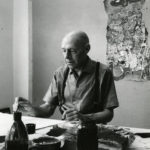Dubuffet, Jean

Jean Dubuffet was born in 1901 in the French town of Le Havre, where his family owned a vineyard. Despite initially pursuing painting, he worked in the family business until 1942. From that moment on, he dedicated his life to art, ascending to become one of the most influential and celebrated french artists of the 20th century.
At the age of 15 he enrolled at the École des Beaux-Arts in Le Havre, where he continued his studies until 1918 when he settled in Paris. He started attending classes at the Académie Julian, but after 6 months he decided to teach himself. Throughout his formative years, he met established artists such as Raoul Dufy, Max Jacob and Suzanne Valadon. Between 1920 and 1922 he led a solitary life and devoted himself to studying philosophy and music.
In 1924 he experienced a personal crisis, questioning the value of art. As a result, he moved back to his hometown of Le Havre to work in the wine business with his father. Soon after he married, he returned to Paris and opened his own wine business in Bercy. In 1930 he tried painting again, but it was not until the autumn of 1942 that he decided to dedicate himself fully to art.
In 1944 he held his first solo exhibition, giving him rapid success. His recognition in the US was in part due to the renown Pierre Matisse Gallery, which featured some of his works in their 1946 exhibitions.
From 1948 until 1954 his work was influenced by surrealism, until he discovered \"Art Brut\", which he defined as art made by non-professionals. His works shine with a distinctive departure from tradition, boldly challenging the established aesthetic canon.
Dubuffet wanted to create free art, painting a combination of both childish and scary characters. He was inspired by drawings of children, criminals and the mentally ill.
From 1962 onwards, and well into the 1970s, he produced paintings and sculptures that were distinguished by their interwoven wefts of cells. This was a significant stylistic change and a new vocabulary for exploring a fantastic and expanding universe. Nevertheless, the painter from Le Havre remained faithful to his commitment to re-aligning the vision of art and the world in a broader way.
He produced most of his works in oil and unconventional materials, such as sand, tar, or straw. These unique materials gave his paintings astounding texturized result, creating his unmistakable style and making him the first artist to use such materials.
The painter and sculptor's last decade was centred on the mechanisms of the mind, focusing on its relationship with the outside world and allowing him to rely on new ways of thinking, which were new and free. Towards the end of his career, Dubuffet had established a vocabulary to express how the mind integrates perception.
He died in Paris on 12 May 1985.

